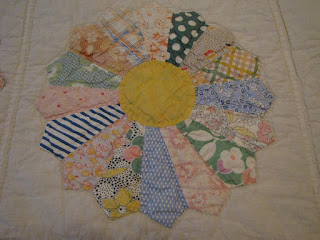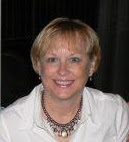I love applique. I really, really love the look of it. I have always been envious of anyone who made applique quilts. Through the years I have taken classes and tried many methods of applique. None of them gave me the look that I wanted-which was needle-turn. So, finally I bit the bullet and decided that I was not getting any younger and if needle-turn was the look I wanted, then I needed to learn to do it. And lots and lots of practice would make me better at it.
I have a quilting friend named Anne (I call her Annie) who's needle-turn applique is so gorgeous that it almost makes me cry to look at it. Her points and curves are as near to perfection as it gets. So, I went to her to learn to needle-turn. She is a wonderful teacher and I am loving it!! I am not nearly as good as Annie-but she has given me the love of needle-turn. I am enjoying the relaxing feel of fabric and needle in hand.
For my first ever needle-turn project, I decided to go BIG! I have heard that the smaller the applique piece, the more challenging it can be to handle. So, I figured the reverse must be true. I found this beautiful book by Blackbird Designs and knew that this had to be my first applique quilt.
The quilt that I am making is called Love Letters. I liked the color palette immediately because it matches the colors in one of my guest bedrooms, so I decided to just go with it. This quilt appealed to me because each of the blocks is a 28" square, so the quilt finishes at 84" X 84" and the individual pieces are not tiny.
Love Letters
The first thing I did was start collecting fabrics. When working on a project that requires lots of fabrics I like to carry samples with me as I go to local quilt shops or quilt shows. Anne taught me this trick of cutting small pieces and attaching them to a note card or paper. Here was my working sample page.
I wanted to make sure that my background fabrics did not clash and that I got a good variety of fabrics-I like to have large and small scale prints and maybe a check or plaid thrown in. Eventually I had gathered a nice variety of fabrics and was ready to begin.
There were several things that I did before I ever began my cutting and stitching. The first was a trip to Staples. I had the spine cut off of my book and had it spiral bound. It is so much easier to trace applique patterns when the pages of the book lay flat. Second, I made reverse copies of the pages that had patterns for leaves and flowers that needed to be reversed.
My first task for this quilt was to make bias tape. Each of the blocks uses it for the stems and the center block uses it for the wreath. I needed 6 1/2 yards of 3/8" bias tape and 11 yards of 1/2" bias tape. I make my bias strips using the "tube method" (you can find videos and instructions on the internet, if you don't know how) and Clover bias tape makers. I then wrapped my bias tape onto cardboard squares for future use.
The first block that I made for the quilt was my "learning curve" block. There were some things that I decided to do differently on subsequent blocks. I learned that I cannot pin all of my applique pieces into place at once and stitch on a block this large and not get poked and scratched by all the pins. But because all of the pieces need to be placed ahead of time to know they are going to fit and be symmetrical I came up with my own way of doing my blocks.
I traced each applique pattern onto freezer paper (if I needed four of a particular leaf, I traced four freezer paper leaves), cut it out on the stitching line, ironed it onto the FRONT of my fabric, traced the pattern onto the fabric, cut each piece out leaving a scant 1/4" seam allowance and then removed the freezer paper. I numbered each pattern piece and it's corresponding fabric piece with the same number.
There is a placement diagram of each block in the book with each square representing 1"-this is SO helpful. I took my background fabric and placed it on my white cutting mat. I can see the 1" grid lines through my background fabric enough to make it easier to place my applique pieces. Next I use my freezer paper pieces and place them onto my background fabric where I want the applique pieces to be. This allows me to move them slightly and fit all the pieces on. I pin each piece in the center when I have them all placed and then I take it to the ironing board and I iron all the freezer paper pieces to my background fabric.
You can see the grid lines through the background fabric.
I then trace all of my freezer paper pieces onto my background fabric using a Pilot Frixion pen. (I know that there is some controversy in the quilting world about whether or not to use these pens on your quilts, but I have not had any trouble with it and will continue to use them.) After I have traced all of the pieces, I number each piece on the background fabric as I remove the freezer paper.
Lastly, I baste my bias stems down so that the pins don't poke me and come out as I am stitching other pieces. After all of this, I am ready to begin my applique!
I started this quilt in December, 2010. I took the book, freezer paper and fabrics with me to the mountains on a post-Christmas vacation. I traced and cut out all the freezer paper pieces that I needed for the first block-the Hedgeapple. I worked on it some off and on through the next few months, making my way slowly through it (it's my first needle-turn and I was a little apprehensive about it.) In December, 2011 I took it back to the mountains with me again and finished the first block! At this rate, the quilt will take me more than 9 years to complete! I started the second block while I was there and stitched on it a little bit every day the first few weeks of January. Other things got in the way and it slowly made it's way to the background, so I am still working on it.
The Hedge Apple Block
After I am finished stitching the block I press it lightly with my iron and the heat will remove all traces of the Frixion pen.
The Bur Oak Leaf (so far)











.JPG)
.JPG)




.JPG)




.JPG)


















